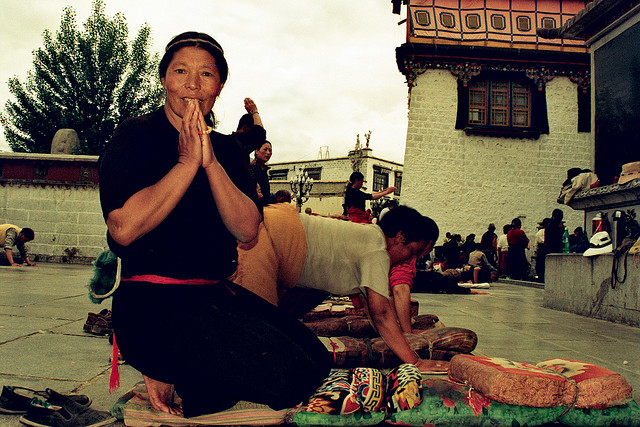Tibetan Cultural Cues: "Tashi Delek"

Tibetan cultural cues are deeply embedded in the daily lives and spiritual practices of the people of Tibet, offering a window into their rich heritage and profound beliefs. At the heart of Tibetan culture lies a strong sense of community, spirituality, and respect for nature and all living beings, guided by Buddhist principles. The traditional greeting "Tashi Delek" embodies good wishes and blessings, reflecting the Tibetan ethos of kindness and goodwill. Hand gestures, such as the offering of a khata (a ceremonial scarf) during greetings, symbolize purity, goodwill, and a warm welcome. Another unique aspect is the practice of circumambulation, walking clockwise around religious sites, which signifies respect and devotion.
A first-time visitor to Tibet stands in front of a local Tibetan. "Tashi delek," says the tourist in greeting to the Tibetan, and back comes the reply: “Tashi delek.” When you visit Tibet for the first time, these two words hold a profound meaning and are universally understood by native Tibetans. They serve as gracious greetings, conveying blessings and creating an instant connection that is bound to bring smiles and foster a sense of rapport.

The Essence of Tibetan Hospitality
We all know the adage, “When in Rome, do as the Romans do,” and traveling in Tibet is no different. “Tashi delek” is the traditional Tibetan greeting used to greet both friends and strangers. It carries wishes of blessing, good health, and luck. Due to their good-hearted nature, Tibetans love to exchange this greeting and will gladly return it when you initiate. Older Tibetans might even open their mouth and stick their tongue out at you, a cultural way of showing that they are sincere!
Tibetans across the Tibetan Plateau respond warmly when tourists say "Tashi Delek" to them, as it is the key to opening welcome communication. It is a powerful way to connect with the local people and show respect for their culture. By embracing this simple greeting, you will experience the genuine warmth and friendliness that characterizes this enchanting land.

How to respond to “Tashi Delek”
Responding to "Tashi Delek" in the appropriate manner is an essential part of engaging respectfully with Tibetan culture. This traditional greeting, which conveys wishes of happiness and good fortune, can be reciprocated simply by repeating "Tashi Delek" back to the greeter. This echoes the goodwill and acknowledges the gesture in a manner that is both respectful and culturally appropriate. For a more personal touch, especially if the greeting is given in a context of genuine warmth or when a deeper connection has been established, accompanying the verbal response with a slight bow and a smile can further convey your respect and appreciation for Tibetan customs. Additionally, placing your hands together in a prayer-like gesture can also be a sign of respect and goodwill, and you can use “Tashi Delek Shu” which is a more native way.
Understanding and participating in these cultural exchanges enhances mutual respect and fosters a deeper connection with the Tibetan people and their rich heritage.
In addition to being a common everyday greeting, "Tashi Delek" holds special significance during the Tibetan New Year, known as Losar. Losar is a vibrant and joyful festival celebrated with great enthusiasm across Tibet. During this time, families gather, traditional rituals are performed, and prayers are offered for a prosperous year ahead. By using "Tashi Delek" during Losar, you become part of the festive spirit and contribute to the positive energy that fills the air.

Exploring Tibet: A Cultural Journey
As you explore the magnificent landscapes of Tibet, interacting with the locals and immersing yourself in the rich Tibetan culture, remember the power of "Tashi Delek." Whether you're exploring the bustling streets of Lhasa, visiting sacred monasteries, or trekking through remote mountainous regions, let this simple greeting be your bridge to connect with the people and forge unforgettable memories.
So, as you embark on your journey through Tibet, embrace the local customs and greet the people of Tibet with a heartfelt "Tashi Delek." Experience the genuine warmth, kindness, and openness that define the Tibetan spirit, and create lasting connections that will enrich your travel experience.

Learn More Tibetan Cues
Tibetan culture is rich with unique greetings and expressions that go beyond the well-known "Tashi Delek." Here are more gestures and phrases that are integral to Tibetan social interactions, reflecting the depth and warmth of their traditions:
Khata Offering: Presenting a white scarf, or khata, during greetings is a traditional Tibetan custom symbolizing purity, goodwill, and compassion. It's often offered during special occasions or when meeting someone respected.
Namaste Gesture: Accompanying greetings with the Namaste gesture, where palms are pressed together near the heart, is common among Tibetans. This gesture signifies respect and is a universal sign of greeting and farewell.
Showing the Tongue: In some Tibetan areas, sticking out the tongue is a traditional greeting. This unusual gesture dates back to ancient times, meant to prove that one is not the reincarnation of a cruel 9th-century king known for his black tongue.
"Jullay": Used in Ladakh and certain regions close to Tibet, "Jullay" can mean hello, goodbye, please, and thank you. It's a versatile greeting that embodies the spirit of hospitality and kindness in the Himalayan regions.
Bowing: A slight bow with the head, sometimes with hands in the Namaste gesture, is a respectful way to greet elders or religious figures. It signifies humility and respect for the other person's presence and stature.
Understanding and using these greetings and gestures appropriately can greatly enrich your interactions in Tibetan societies, showing a deep respect for their culture and traditions.
How about starting to plan your Tibet tour now with our travel experts?
Recommended Tours:





















